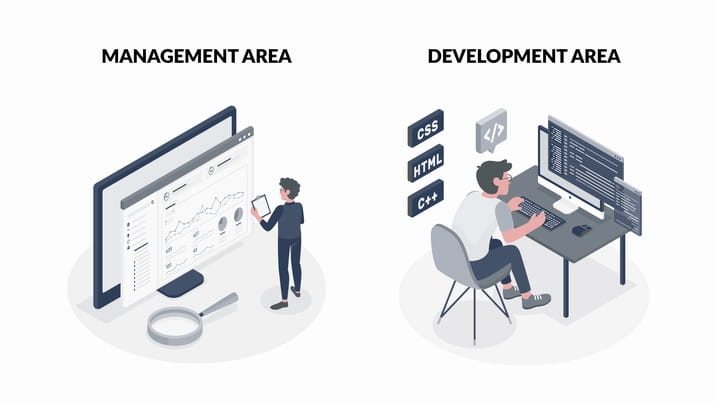All over the world, a huge number of project managers perform various software products. Most of these products do not always meet customer expectations in terms of budget, quality, and timing. Often, part of all projects exceeds the cost and lags behind in terms of deadlines. Not to mention the poor quality of execution of these projects.
To tell about the UK, it has been referred to as a “powerhouse” of the global app development market, and for iOS, Android, and Cross-Platform, the data backs it all up. Of its 8000 app-development-related companies (around a fifth of all European app development agencies), 31% are located in the capital and about 25% of those in the south-east part of the city.
So, there are a lot of highly qualified teams that try to do their best to create a great product.
But there are some reasons why there can be a failure during the software product development planning process.
The reason for the failure of software products is incorrect project management.

- Poorly defined goals
- Poor planning
- Frequent changes in technologies and tools
- Lack of management and product development methodology
- Lack of qualified developers (lack of experience).
To solve all these problems, you need to work out the process of managing the development of a software product: draw up a plan and develop a set of techniques aimed at a balanced development process that will cover the project management from the beginning – from the moment of making the decision to create, to the end – putting the project into operation.
Unfortunately, there are no unified methods that would be suitable for absolutely any project, since each project is individual in its own way.
The entire process of creating a software product comes down to the area of management and engineering/development.

The development area includes the main processes:
- Analysis
- UI and UX design
- Software design / software architecture
- Programming (implementation)
- Testing
The management area includes the main processes:
- Planning
- Development activities’ control
- Development deadlines monitoring
When we develop small software products, the plan may be small and consist of several items, and in some situations even verbally discussed between performers.
However, when it’s large commercial software products, the entire plan should be clearly described, the process should be based on established methods, the product should be carefully documented, and all tasks should be planned and tracked.
The plan for creating a software product should describe the entire development process and related tasks, based on the accumulated experience and success of past projects. This will help ease many tasks and avoid situations that lead to product failure.
Identify tasks, break them down into milestones, and anticipate deadlines – this is a necessary step on the way to achieving your goals. Especially when it comes to flexible Agile methodology, which we consider the best.
Development teams make the following mistakes when planning to create software.
The time for the work is planned by managers, not programmers
A common mistake is when the Project Manager, who does not properly understand the scope and specifics of the tasks, sets the project deadlines not in accordance with the experience, capabilities, and competencies of the team, but based on their own ideas, desires or requests of the client. Programmers in such groups are not to be envied. The discrepancy between the planned and actual dates is 40-80%. The atmosphere in the team is oppressive and discourages the desire to work. Problems follow one after another, and the blame is placed on the direct developers.
Not planned deadlines and no reserve time for the project in advance

In no case should processes be allowed to take their own course. Ignoring the planning procedure leads to slackness, low motivation of developers in the periods preceding the deadline, to a lack of understanding by the team of what to do, where to move and what to get in the end. In associations where approximate deadlines for project completion are not defined, it is advisable to think about the fact that such chaos will not lead to good.
The project is not broken into small phases; no objectives and mandatory results and discussion
The application of the principle is necessary to counter Parkinson’s law, which determines that the total amount of work will always increase to fill all the time allocated for work. Following the advice, you can avoid the desire to work hard only shortly before the deadline for the project. Splitting the process of achieving a global goal into control periods with the need to complete specific tasks within a week or two will allow you to use the team’s working potential to the maximum. This approach maintains a high level of motivation and efficiency of developers throughout the entire period of SOFTWARE creation and increases the probability of achieving the desired goals.
Members of the team do not interact with each other
First of all, it increases team cohesion and encourages mutual assistance. If there is insufficient communication between the members of the Association, there is no “team spirit” that ensures smooth work. Joint productive activity meets the social needs of a person in the sense of the significance of the work performed. Following the principle allows you to replace any team member painlessly because the participants know who is doing what and how.
No time to cover force majeure, new customer requirements, vacations and holidays, integration, and testing includes.

At the initial stage of planning, you can not foresee all situations. Therefore, you need to reserve time in reserve so that the team does not have to hurry and, as a result, make mistakes. Do not ignore the need to debug and bring the SOFTWARE to the level of stable operation and an acceptable number of bugs. The production of the crude product from the austerity of the time is not reasonable. The Agile methodology assumes the variability of external conditions and the need for quick and painless adaptation to them.
The team tries to reduce the time and take the time when software development – with lack of quality work
It is a common mistake for managers who think that programmers can pull any deadlines. First, the team is demotivated, sabotages the labor process, or writes statements of their own volition. Secondly, a sharp acceleration of work operations drains the resources of the human body and psyche, leading to professional burnout. Third, an excessive rate leads to an increase in the number of errors in the code. Debugging and patching in the future will take much longer than you can save in this way.
The work is not documented in a special project- and task-management system

Choosing a specific program is a matter of taste. Plans should be recorded. Visibility is required for both developers and clients, while still allowing changes to be made. This improves the mutual understanding between the development team, management, and the client. The number of disputes regarding the interpretation of work actions is reduced. The clarity in the wording of the plan will help avoid ambiguity.
No prioritized tasks and focus on what’s important
Try to implement the most important functionality first. Keep in mind that some features in the development process will have to be sacrificed, as well as the implementation of some of the ideas. And it is possible to set priorities only through communication and exchange of opinions.
So, if you want to create a website, mobile app or any other IT product, we’d suggest you to find a team, that will meet all your demands and requirements and will do their best, to complete the whole package of the custom software development services. Omertex is a five-star technology consultancy that helps businesses to turn ideas into reality by creating software products and accelerating growth. We provide software development services for SMEs and startups all over the world.


